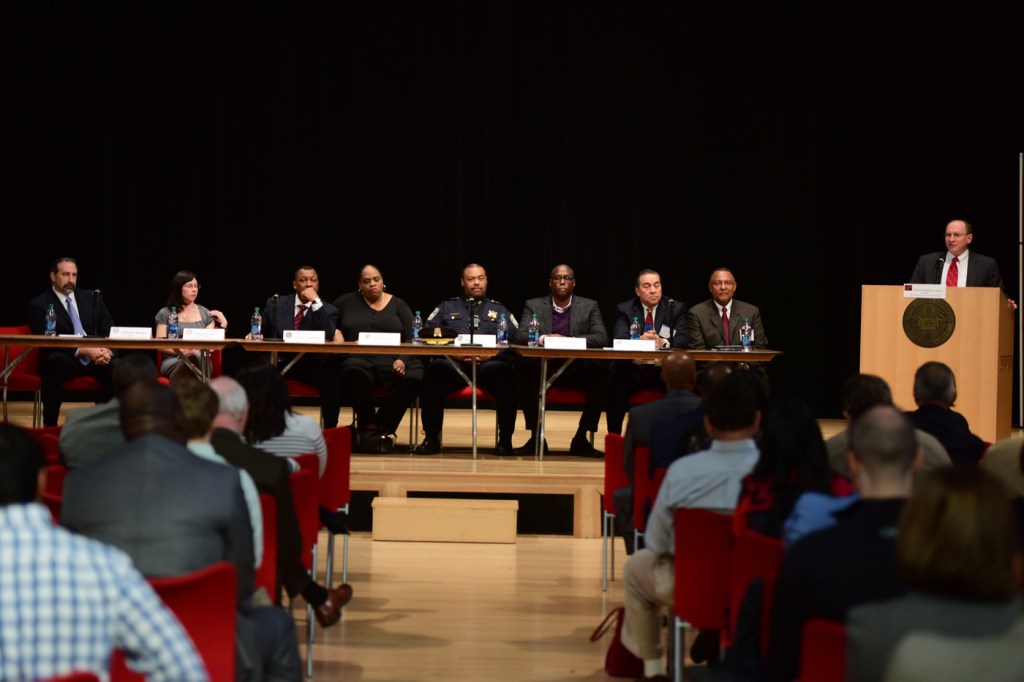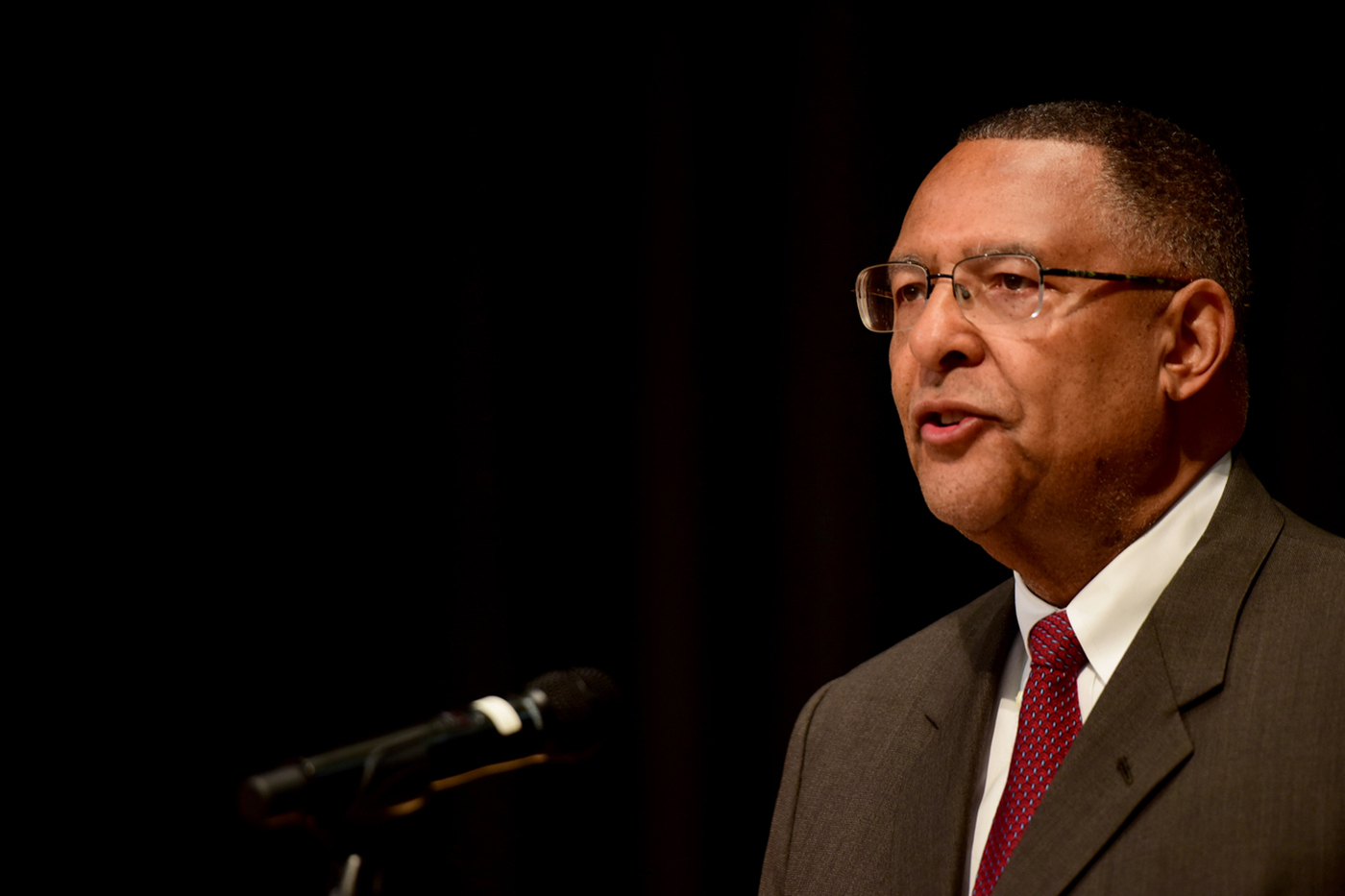Experts cite collaboration as key tool in eliminating racial disparities in justice system

Collaboration is key to improving race relations in Massachusetts and beyond, particularly in regard to the treatment of underrepresented minorities in the criminal justice system. That was the prevailing opinion among a distinguished group of judges, academics, law enforcement officials, and community leaders who convened on Friday at the Fenway Center for a wide-ranging meeting on race and criminal justice in America today.
“We’re all going to have to work together in order to have a bright and positive future,” said William Gross, the superintendent-in-chief of the Boston Police Department, whose sentiments were echoed by fellow panelists throughout the discussion. “Once we recognize we have the same needs and concerns, then we can really have justice for all.”
Gross was one of nine experts who took a hard look at the intersection of race and justice during the three-and-a-half-hour event, which was sponsored by the Justice George Lewis Ruffin Society in conjunction with the BPD and Northeastern’s College of Social Sciences and Humanities.
Named in honor of the nation’s first African American judge, the Ruffin Society aims to promote the advancement of minorities within the field of criminal justice. The group’s president, Roderick Ireland, moderated the event.
“We think race and criminal justice is a topic of critical importance,” said Ireland, former chief justice of the Massachusetts Supreme Court and current Distinguished Professor of Criminology and Criminal Justice at Northeastern. “It impacts each and every one of us in different ways.”
He put the meeting in context, citing a March Gallup poll in which 42 percent of respondents said they worry a “great deal” about race relations in the United States, a record-high since the polling firm began tracking the matter in 2001. “The bottom line is that race relations, one of the top concerns in the 1950s and 1960s, has returned as a major issue this decade,” Ireland said, quoting from the report.
We’re all going to have to work together in order to have a bright and positive future. Once we recognize we have the same needs and concerns, then we can really have justice for all.
William Gross
superintendent-in-chief of the Boston Police Department
‘We’re losing too many people in our society’
Each panelist—including Northeastern faculty member Amy Farrell, Suffolk County Sheriff Steven Tompkins, and Boston Municipal Court Chief Justice Roberto Ronquillo Jr—made a brief presentation on race and criminal justice from his or her perspective as an expert in the field. Some looked at racial disparities in sentencing, others the ethnic make-up of the incarcerated population. But all emphasized the importance of collaborating to foster a deeper understanding of these issues among key stakeholders.
Ralph Gants, the chief justice of the Massachusetts Supreme Court, focused on race and implicit bias in the state’s judicial system. He noted that the state’s Trial Court and Supreme Judicial Court sponsored a judge’s conference on the topic in 2015, following a spate of police killings of unarmed black men in Baltimore, Ferguson, Missouri, and Staten Island, New York. “We have to become more mindful about what we do and what we think we know,” he said, referring to judges across the country. Finding a solution to the problem of implicit racial bias in the courts, he added, “involves listening to things many of us don’t want to hear and what we may think is not true.”
Gants later turned his attention to the mass incarceration problem in certain parts of Boston. He cited a 2016 report from the Boston Indicators Project that found that “incarceration was a reality for almost 50 percent of households” in five Boston neighborhoods—Grove Hall, Dudley Square, Codman Square, Fields Corner, and Franklin Field.
“Part of this discussion needs to be in recognition of the fact that that we’re simply losing too many people in our society,” he explained. “We are a poorer society when we manage to not make good use of talents and resources of too large a share of our population.”
Panelist Anthony Braga, director of Northeastern’s School of Criminology and Criminal Justice, knows of what Gants speaks. He has been working in conjunction with the Boston Police Department for more than 20 years, analyzing policies and developing programs aimed at reducing the city’s violent crime rate in neighborhoods like Orchard Park, Eagle Hill, and Downtown Crossing.
His findings have revealed that the vast majority of shootings in Boston occur in just a few so-called hot spots. In particular, his data show that 75 percent of the city’s shootings over a 30-year period occurred on just five percent of its blocks and intersections. “When you look carefully at the data, you see that serious gun violence in cities is highly concentrated in a small number of places among a small number of people,” he said. “The challenge for the city of Boston and its police department is figuring out how to manage this small number of people.”
For him, collaboration is crucial. “Having these kinds of conversations,” he said, in reference to Friday’s meeting, “is a key step in moving forward.”
Tompkins echoed Braga. He oversees the care and custody of more than 1,000 inmates and pre-trial detainees at the Suffolk County House of Corrections and the Nashua Street Jail, 65 percent of whom are either black or Latino. “I believe we are our brother’s and sister’s keepers,” he said. “The hallmark of a vibrant society is how we take care of our most compromised individuals,” he added, noting that 70 percent of inmates in his community’s facilities are sentenced due to drugs while more than 40 percent have some form of mental illness.
The Suffolk County Sheriff’s Department’s Family Matters Program, he said, is working to connect families of incarcerated individuals to resources that will help to prepare them for their loved one’s return home. “It is critically important that we try to fortify the household so that people don’t go back to dysfunctionality, which might lead to recidivism,” said Tompkins, who challenged the audience to “become ambassadors and advocates for keeping citizens out of the incarceration system.” As Ronquillo Jr. noted, “It is very difficult to send someone to jail. It’s saying that we, as a society, have failed.”

Roderick Ireland, Distinguished Professor of Criminology and Criminal Justice at Northeastern, moderated the three-and-a-half-hour meeting on race and justice in Massachusetts and beyond. Photo by Matthew Modoono/Northeastern University
From fugitive slave laws to the War on Drugs
Farrell, associate professor of criminology and criminal justice, cited a slew of stats to underscore the racial disparities in the criminal justice system. She focused in particular on what The New York Times called “the disproportionate risk of driving while black.”
According to Farrell, black motorists in Ferguson were three-and-a-half times more likely to be pulled over than their white counterparts following the fatal shooting of Michael Brown in summer 2014. As the Justice Department found in a 2015 report issued in the wake of the shooting, black people in Ferguson account for 85 percent of traffic stops and 90 percent of tickets.
And that, noted Farrell, is par for the course. “Ferguson is very similar to what we see across the U.S.,” she explained. “When you look at the data, it was quite ordinary in comparison to racial disparities in traffic stops across the country.”
Andrea Cabral, Massachusetts’ former secretary of public safety, was not surprised to hear these stats. For black people, she said, being treated unfairly based on the color of their skin “is a life experience that is so common and so consistent as to be imperial.”
The way she sees it, the more things change, the more things stay the same. “One of the reasons we continue to have these conversations is because we fail to look at how linear things have been throughout history,” she said, pointing in particular to racial injustices levied by the Fugitive Slave Act of 1850 and the War on Drugs in the 1980s. As she put it, “It is not a great leap from lynching to some of what you see happening today.”
She suggested that people take the Ancestry.com DNA test to discover their true racial heritage, the results of which might be quite different from what they believe. “That would be the quickest way to saying, ‘Oh, I’ve been making fun of my own people all this time.’”
Indeed, education was a popular theme throughout the meeting. J. Larry Mays, a member of the BPD’s Community Ombudsman Oversight panel, underscored the importance of teaching and learning. “We have to teach young people how to think critically about the messages they’re receiving and how to create new media that has a direct impact on the narrative that affects their lives,” he explained.
During the Q&A, a judge in the audience asked the panelists how the notion of white privilege factors into their training and decision-making. “We address fair and impartial policing as well as procedural justice,” said Gross, who noted that he is “as transparent as can be when it comes to who you can talk to if you feel your rights have been violated.”
“We totally encourage our officers to interact with the community to learn about whom they serve and their back stories,” he explained. “We have several white officers who give kids breaks, who go to the courts and say ‘this isn’t exactly a bad kid.’”
Cabral replied too, taking a different approach. “The difference in response to the crack epidemic and the opioid epidemic is race-based, but that is historically the way it has happened,” she said. “Teaching people about white privilege is an enormous challenge, particularly in law enforcement, because a fish doesn’t know it’s in water.”
It was an open and honest exchange between Gross and Cabral, the likes of which Ireland encouraged at the outset of the meeting. “Without open communication,” he said, “things can’t and won’t change.”





